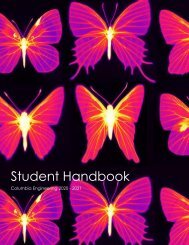Undergraduate Research Showcase
- No tags were found...
You also want an ePaper? Increase the reach of your titles
YUMPU automatically turns print PDFs into web optimized ePapers that Google loves.
Quantifying Myosin Networks and Their Roles in Morphogenesis<br />
Cole Allan, cja2160@columbia.edu<br />
SEAS ‘21, Mechanical Engineering, Columbia University<br />
Supervising Faculty, Sponsor, and Location of <strong>Research</strong><br />
Dr. Karen Kasza, Bonomi Summer Scholar, Kasza Living Materials Laboratory,<br />
Columbia University<br />
Abstract<br />
Morphogenesis is a process during embryonic development in which cells and/or tissues<br />
develop their shape. These morphogenetic events utilize a network of motor proteins,<br />
non-muscle myosin II, to generate forces. Thus, being able to identify and characterize<br />
this network makes it possible to synthetically control tissue folding, and, potentially in<br />
the future, build robust tissue architectures out of 2-dimensional tissue sheets. The goal of<br />
this study, completed virtually in the Kasza Living Materials Laboratory, was to develop<br />
a software tool that would identify the myosin networks within Drosophila embryos at<br />
various stages of development and to quantitatively assess how the myosin networks<br />
influence the propensity of tissues to remodel. Using confocal microscopy, supracellular<br />
myosin networks were fluorescently tagged in high resolution movies. Some of the<br />
properties analyzed in the developed software include measuring the network<br />
connectivity, measuring the flexibility of each network edge, and identifying regions of<br />
rapidly changing myosin. These properties are essential to characterize the structure of<br />
myosin networks. Specifically, we found that myosin segments became less tortuous<br />
when there was tissue elongation in the same orientation. Additionally, the cell velocity<br />
was tracked to identify distinct regions of tissue that behaved more fluid-like. In the<br />
future, with this understanding of myosin networks and cellular movement, we are<br />
hopeful that we will be able to coordinate cell behavior and manipulate the mechanical<br />
properties within tissues.<br />
Keywords<br />
Morphogenesis, Drosophila melanogaster, Myosin Networks<br />
4








